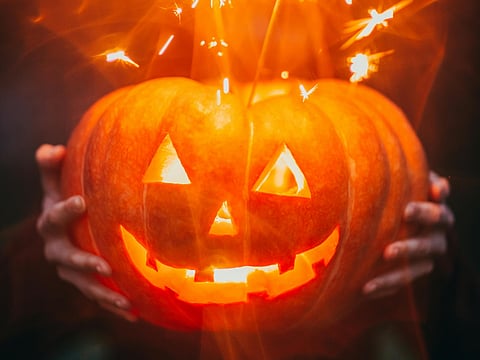Why do we celebrate Halloween with pumpkins?
The spooky fest is all about traditions that go back 2000 years

Halloween isn’t Halloween without pumpkins. From glowing jack-o’-lanterns on doorsteps to pumpkin-spiced treats taking over cafes, these orange scares are everywhere once spooky season rolls around. But have you ever wondered why pumpkins became the undisputed stars of Halloween? The answer is part folklore, part mischief, and a whole lot of history that’s surprisingly weird, sometimes hilarious, and occasionally downright spooky.
Before they were carved into grinning faces to scare off spirits, pumpkins (and their turnip cousins) had centuries of mystical traditions attached to them. Today, they’re the symbol of everything fun, eerie, and festive about October 31.
Ready to get schooled in pumpkin lore, shocking traditions, and quirky facts you definitely didn’t know? Here are 10 things about Halloween.
1. Halloween’s ancient roots
Halloween started as Samhain, an ancient festival marking the end of the harvest and the start of winter. Communities lit bonfires and told stories of spirits roaming the earth.
One of Halloween’s most fascinating origins can be traced to County Meath, at the ancient Hill of Ward (Tlachtga).
This historic site was believed to be a major centre for Samhain celebrations, where the Celts lit ceremonial fires to welcome the new year and guide wandering spirits. The bonfire at Tlachtga was said to be the largest in Ireland, its flames visible for miles, and embers from it were shared with other communities—symbolising unity and protection as winter approached.
Archaeologist Dr Steve Davis of University College Dublin, part of a team working at Tlachtga in the summer of 2014, explained to the BBC “There are very few monuments in Ireland that we consider comparable to this.”
“It is a magical and mystical place,” he added.
He also noted, “We have found evidence of intense burning there, whether you want to equate that with Samhain or not.”
2. Jack-o’-Lantern beginnings
Before it was a Halloween staple, the term jack-o’-lantern wasn’t about pumpkins at all—it described the “ignis fatuus” (literally “foolish fire”), or will-o’-the-wisp in English folklore, a mysterious light flickering over marshes in East England. The Oxford English Dictionary traces the term back to 1658 for the ghostly light, and by 1663 it could mean a night watchman with a lantern. By 1837, jack-o’-lanterns finally took on the form we know today: a carved turnip or pumpkin (OED).
Carving vegetables has been a global pastime, but Ireland and Britain made it a Halloween thing. In the 19th century, turnips or mangel wurzels were hollowed out and grotesquely carved across England, Ireland, Wales, and Scotland. In Gaelic regions, Halloween—Samhain—was a night when supernatural beings supposedly roamed. In Wales, spooky nights were Ysbrydnosau, with Calan Gaeaf marking October 31.
Jack-o’-lanterns the purpose of warding off evil spirits or giving friends a good scare. From foolish fire to Instagram-ready pumpkins, jack-o’-lanterns have always been about mischief, mystery, and a little showmanship.
3. Pumpkins are everywhere
From lanterns to lattes, pumpkins dominate modern Halloween. In the UAE, pumpkin-spiced treats and décor are now popular in malls and cafes, letting families join the festive mood without any spooky stress.
4. Costumes were originally for confusing spirits
In Samhain, people wore masks to trick wandering spirits. Today, it’s all about creative fun—from witches and zombies and werewolves.
5. Trick-or-treating has evolved
The 'trick-or-treat' tradition stems from medieval guising and souling, where people went door-to-door offering prayers or performing songs for treats. The modern candy-filled version took off in the US. in the 1920s and ’30s.
6. Black and orange are symbolic
Orange represents the harvest and autumn, while black symbolises darkness and mystery. Together, they form the classic Halloween aesthetic.
7. Spooky animals
Bats, black cats, and owls were long thought to haunt Samhain nights. Now, they mostly appear as decorations or costume motifs.
8. Candy mania
Halloween is serious business: in the US, as of 2024, people have spent over Rs.41 billion, according to Reuters on candy annually.
9.Halloween in pop culture
Movies like Hocus Pocus and Halloween turned the holiday into a global phenomenon, inspiring decorations, costumes, and themed parties everywhere—including UAE malls.
10. Haunted Houses aren’t new
The first commercial haunted house attraction is widely credited to the Orton and Spooner Ghost House, which opened in 1915 at an English fairground in Liphook. This attraction featured mechanical devices, spooky sound effects, and costumed actors to create a terrifying experience for visitors
In the United States, the concept of haunted houses gained popularity during the Great Depression. Faced with economic hardships, communities organised DIY haunted houses in basements and community centers as a form of inexpensive entertainment. These grassroots efforts laid the foundation for the haunted house industry in America.
The 1970s marked a significant shift in haunted house attractions. In 1973, Knott’s Berry Farm in California introduced "Knott’s Scary Farm," one of the first theme park-based haunted events. This innovation combined the thrill of haunted houses with the scale and resources of theme parks, setting a precedent for future attractions, according to the Heritage Herald.
Following this, other major theme parks, including Universal Studios with its "Halloween Horror Nights," adopted and expanded upon the haunted house concept, incorporating elaborate sets, advanced special effects, and immersive storytelling.
Sign up for the Daily Briefing
Get the latest news and updates straight to your inbox






